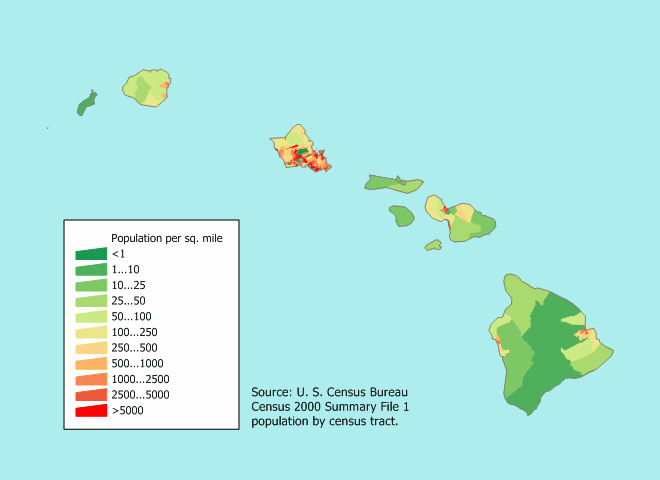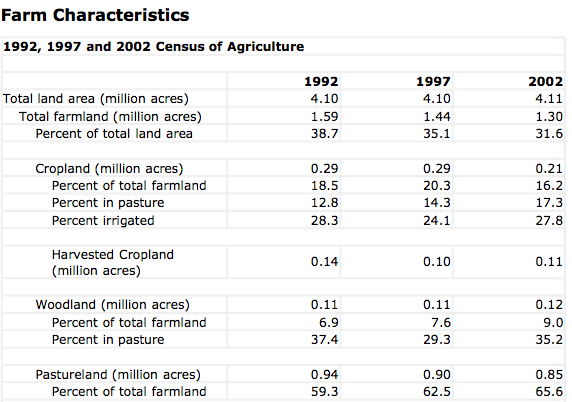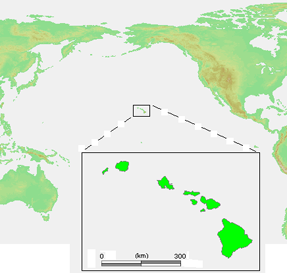SUBHEAD: Hawaii is that canary. No food or fossil fuels and a long way from them Hawaii will show the way to the future. SOURCE: Elie Starbright (elielstarbright@gmail.com)
By Gail the Actuary on 22 June 2008 in The Oil Drum - http://www.theoildrum.com/node/4192 Hawaii seems to come up often in the thinking of people aware of peak oil. On one hand, it seems like an ideal place to relocate after peak oil - no need to worry about heating a house; clothing is mostly for protection from the sun; and crops can be grown year around. On the other hand, it produces no fossil fuel itself, and it is at the end of the supply line for both food and fuel. Hawaii's biggest industry, tourism, is already declining, and with rising fuel costs, can only decline further.
Many of you know that I was recently in Hawaii. After visiting, I thought I might post a few of my thoughts about the situation.
When I visited Hawaii, I spent most of my time on the "Big Island" (with more land area than the other islands put together) and Maui (the next island north of the big island). These islands are probably the most agricultural of the Hawaiian Islands. I also visited Oahu, home of Honolulu and most of the population.
Hawaii varies a lot from place to place
One of the first things one notices is that Hawaii is a mixture of very densely populated areas and areas with virtually no people. This is what a population density map of Hawaii looks like:

When one travels around, the reason for this disparity in population density becomes clear. Most of the islands are very rugged mountains, but there are a few flatter areas where most of the people live. The soil quality also varies greatly from place to place. In some areas, particularly on the Big Island, there is not really soil, simply volcanic rock, with nothing growing on it, because the eruption giving rise to the land is very recent. Even where there is soil, the underlying volcanic rock tends to make the soil drain quite quickly after it rains.
The climate varies greatly, even with a few miles, because of the rapid elevation changes and the tendency of rain to fall on the eastern side of the islands. Most of us think of Hawaii as quite lush and green, but there is a much larger area which is very dry. High elevations can be very cool, and even can be snow-covered in winter.
What are the advantages Hawaii has from a peak-oil perspective?
1. Many are aware of Peak Oil and are concerned about the problem.
One thing I was surprised at was how aware people are of the problems, especially on the Big Island. On the way out, the woman I was sitting next to on the flight from Honolulu to Hilo (on the Big Island) brought up the issue of oil shortages, and said the local paper talked regularly about the Big Island's vulnerability to oil shortages and high proportion (90% plus) of imported food.
I gave talks to two different groups in Hilo--one was an energy forum consisting of about 150 business people and politicians discussing Big Island energy issues; the other was a group of Hawaiian people interested in sustainability. The energy forum got very good local press coverage. I was surprised that so many people were aware of peak oil, and were interested in finding solutions.
2. Fairly large population on the Big Island before fossil fuels.
When Europeans first discovered the Big Island, people lived in self-contained communities of 250 to 500 people. These communities occupied rectangular or triangular strips of land along streams. These strips went all the way from the ocean to the closest mountain top. Because climate changes so rapidly, these strips of land, called ahupua`a, offered a range of climates and soil conditions for growing many different types of foods. They also provided areas for fish ponds for farming fish. According to Robert Oaks "Hawaii: A History of the Big Island", there were about 600 of these ahupua`a, when Europeans first discovered the island.
If we multiply the number of people per community times the number of communities, we get quite a large population. If there were 250 to 500 people per ahupua`a, and 600 of these communities in total, this would suggest a total population of 150,000 to 300,000. I would find the upper end of this range difficult to believe. The current population of the Big Island is only about 135,000.
3. Some still remember pre-fossil fuel approaches.
Knowledge of the history of what was done in the past seems quite a bit better than on the mainland. Europeans first visited the Hawaiian Islands in 1778, which was not all that long ago. Hawaiians continued to rule the island until 1893. This was only a little over a hundred years ago. When I visited the Bishop museum in Honolulu, I discovered one could look at black and white photographs life under Hawaiian rule. While Western illnesses killed quite a few of the native Hawaiian people, many survived and passed down at least some of the traditions to their children.
4. Little need to heat or cool buildings.
Hawaii is known for its mild climate. On the coast, the temperatures are in the 70s and 80s in the daytime, and a little lower at night, year around. It gets cooler at higher elevations, so that one needs a fireplace for warmth.
A mild climate has many other benefits as well. One doesn't need insulation, and in fact, one can get along with just a thatched roof held up by poles for many uses.
Before Europeans came, Hawaiians wore little clothing. Those of us with fair skin would probably need clothing, simply to prevent sun burn.
5. Built in water transportation system.
Moving goods and people by boat is usually a very low energy mode of transportation. WIth ocean all around the islands, boats or barges can easily be used for transport.
6. Year around growing season.
With a very mild climate, it can be possible to grow two or three crops a year.
7. Availability of ocean to supplement food needs.
With the ocean nearby, there is the possibility of catching fish to supplement other food sources. Fish can also be farmed, sometimes even in a netted-off section of the ocean.
Eating sea weed is another possibility, as the Japanese do.
8. High rain fall in parts of the island.
A shortage of water is often a limiting factor for growing food. Parts of the Hawaiian Islands get over 100 inches of rain a year.
9. Geothermal, wind, solar, and water currents as energy sources.
There is currently one geothermal plant generating 30 MW of electricity on the Big Island, and there is the theoretical possibility of more generation, both on the Big Island and on Maui.
Parts of the islands are very windy, so wind generation is a possibility, and, in fact, is currently being used.
The islands are well situated for solar energy of all types (solar thermal, solar PV, and solar concentrating). If methods for using water currents to generate electricity are perfected, Hawaii will have this as an option as well.
What are the disadvantages Hawaii has from a peak-oil perspective?
1. Distance from rest of world.
Hawaii is a long way from any other occupied body of land. It is 2,390 miles from California; 3,850 miles from Japan; 4,900 miles from China; and 5,280 miles from the Philippines according to this source. The one thing this is good for is as a location for refueling aircraft. Apart from this, it means that everything must be transported over very long distances to get to Hawaii.
2. Agriculture is small scale; difficult to scale up.
Because Hawaii is so mountainous, it is difficult to do commercial agriculture. Also, the large amount of volcanic rock in the soil in many areas makes crops more variable than commercial equipment is designed to handle.
A publication of the US Department of Agriculture shows these statistics for Hawaii agriculture, for all of the islands combined:

The way I read this, Hawaii in 2002 had only 110,000 acres of harvested cropland. Of this, approximately 58,000 acres (.21 x 27.7% x 1000) was irrigated. In 1992, the figures were a little higher than this, with 140,000 acres of harvested crop land and 82,000 irrigated. We know that quite a bit of sugar cane and pineapple (both irrigated) has left Hawaii in recent years, so this probably explains the drop.
There is quite a bit of pasture land, but this is generally very dry and often very steep. Without irrigation, it is unlikely to be productive as farmland.
3. Vulnerability to tsunamis, volcanos, blights, climate change.
Because of its location, Hawaii is vulnerable to tsunamis, particularly along the coast, which is where most of the population is. The Big Island had a railroad at one time, but many of its bridges were destroyed by a tsunami in 1946. It was never rebuilt.
Since Hawaii is small, it is easy for it to be affected by impacts that would tend to average out over a larger area. If Hawaii grows a large amount of a single type of crop, it is possible that a pest or blight will attack the crop, and the whole crop will be lost. If a crop is planted, and the weather suddenly changes, the crop could be lost. This means that if Hawaii cannot depend on trade, it needs to keep some surplus, in case crops do not turn out as planned.
4. Lack of fossil fuels.
All of Hawaii's fossil fuel is imported. Most of this is oil (used for both electricity and transportation). Some coal is also imported for electricity. Hawaii uses very little natural gas. The lack of fossil fuels makes manufacture difficult, and makes the islands very dependent on imports.
5. Lack of metals and clay.
Hawaii was in the stone age until Europeans came and brought metal in 1778. Until I visited the island, it never occurred to me that the problem was a lack of metal ores. Also, without fossil fuels for heating the ores, it is not clear that ores would have been of much use. Early Hawaiians lacked nails, metal knives, metal pots, coins, and many other things we have come to expect.
The island is also without clay, so there is no pottery or bricks. Before Europeans came, food was wrapped in the leaves of the ti plant, and baked underground. Hollowed out gourds were used for transporting water.
6. Excessive population.
If the only island that one had to worry about from a sustainability point of view were the Big Island, the population would probably not be too far out of line with its resources. The total population of Hawaii is currently estimated at 1.28 million. If one compares this to current harvested cropland of 110,000 acres, this would equate to nearly 12 people per harvested acre. A ratio of about 1 to 1 perhaps 2 to 1, considering the long growing season, would be much better.
If Hawaii's problems become clear before those of the rest of the US, it is possible that quite a few people currently living in Hawaii will move to the mainland. This would be helpful, from the point of view of balancing the population with the available resources.
7. Belief in "right" way to do things.
Clearly, one way of attacking the problem is to try to go back to the old (pre-1778) way of doing things. Another is try to use technology to work one's way out of the problem.
Our current set of laws, regulations, and belief systems very much favors the technological approach. There are laws saying how buildings should be built. We have expectations as to how people should be dressed. Property ownership laws are such that the status quo is the most likely outcome--big businesses have large tracts of lands; most individuals have postage stamp size lots. All of these pretty much predetermine what the outcome will be.
What are the current risks?
Hawaii's biggest industry is its tourist industry. It seems likely to me that Hawaii's tourist industry will largely disappear in the next few years, as oil prices rise. Two Hawaiian air lines have already gone out of business, and two cruise lines have stopped serving the Hawaiian Islands, leaving only one cruise line serving the islands. So far, the islands away from Honolulu have been hardest hit by the drop in tourism. It seems like the situation can only get worse.
Another large source of revenue is the US military. On my way to Honolulu, there were about 30 American service men and women on the plane with me. I asked one sitting next to me where he was going. He said the whole group was on its way back to their home base in Hawaii, on leave from tour of duty in Iraq. They had flown from Iraq, through Europe, across the Atlantic to Atalnta, and now were on their way to Honolulu, to be with their wives and families. I asked the serviceman where he had been before he joined the service, and he said the US Northeast.
It is hard for me to believe that it makes economic sense to send service men and women circling the globe, all the way from Hawaii to Iraq (the long way around!), especially when they did not live in Hawaii to begin with. I would think it would make sense to scale back US military operations in Hawaii. Hawaii is needed as a refueling point, and possibly for defense, but it is hard to see how it makes sense to station a large number of service people there, when their ultimate destination is Iraq.
A smaller source of revenue is agricultural products. Hawaii exports some sugar cane, pineapple, macadamia nuts, and coffee. Prices for these goods can be expected to rise, as the price of oil increases. It is possible that these exports may be able to continue, if enough oil can be imported to keep all the necessary infrastructure maintained and the machinery operating, and if demand for the products continues at the new higher prices. One problem with these industries is that they use up most of the Hawaii's cropland, leaving little for other crops.
What are Hawaii's options going forward?
This is really too big an issue to discuss here. Perhaps I can talk about it more in a later post.
I think one of the issues is that Hawaii is currently a state that imports a lot of products, and mostly sells products like tourism and military bases. If it loses its "exports", where does it get the funding to continue buying imported food, gasoline, televisions, and asphalt?
All of our current belief systems would seem to dictate trying to find a high tech way out. Yet I have a difficult time thinking of new products Hawaii could sell to generate revenue to replace the revenue it is likely to lose from tourism and the military. Selling long distant services (computer programming or customer service) would seem to be an option, but it would seem like Hawaii's costs would be higher than those of competitors.
Going back a few years to earlier approaches doesn't seem offer any likely alternatives. Years ago, Hawaii exported salted beef. Fish was also salted, as a low-energy way of preserving it. I don't see a big market at this time for salted exported meat and fish. Before that, Hawaii's big industry was whaling. That doesn't seem to have a big future either.
Manufacturing doesn't seem very likely either. If manufacturing were undertaken, it would need to be done with local resources. Without metals, it seems like it would be hard to do very much. Power would need to be supplied by electricity, generated from an available source, such as wind or geothermal. The products would need to be ones of very high value, because of the high cost of shipping products to customers. I can't think of anything that would work well, but perhaps it is just my lack of imagination.
Another approach might be to look at what worked before Europeans came, and see what could be added to it, that might still be sustainable. Over two hundred years ago, people lived in narrow communities along streams called ahupua`a, and traded with people who lived near them. Would it make sense to go back to a system closer to the very old one? What changes would be needed to make such a system work, and be acceptable to people living there?
Certainly we could make tools from abandoned cars and trucks for a very long time, to supplement the natural resources. Locally generated electricity might be added as well.
Going back this far would require huge changes in belief systems, and probably changes in land ownership rules. I am not sure how one would even contemplate such a major change.

No comments :
Post a Comment